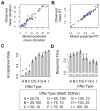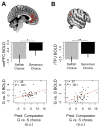A Neurocomputational Model of Altruistic Choice and Its Implications
- PMID: 26182424
- PMCID: PMC4947370
- DOI: 10.1016/j.neuron.2015.06.031
A Neurocomputational Model of Altruistic Choice and Its Implications
Abstract
We propose a neurocomputational model of altruistic choice and test it using behavioral and fMRI data from a task in which subjects make choices between real monetary prizes for themselves and another. We show that a multi-attribute drift-diffusion model, in which choice results from accumulation of a relative value signal that linearly weights payoffs for self and other, captures key patterns of choice, reaction time, and neural response in ventral striatum, temporoparietal junction, and ventromedial prefrontal cortex. The model generates several novel insights into the nature of altruism. It explains when and why generous choices are slower or faster than selfish choices, and why they produce greater response in TPJ and vmPFC, without invoking competition between automatic and deliberative processes or reward value for generosity. It also predicts that when one's own payoffs are valued more than others', some generous acts may reflect mistakes rather than genuinely pro-social preferences.
Copyright © 2015 Elsevier Inc. All rights reserved.
Figures







References
-
- Andreoni J. Impure altruism and donations to public-goods - a theory of warm-glow giving. Econ J. 1990;100:464–477.
-
- Andreoni J, Bernheim B. Social image and the 50–50 norm: A theoretical and experimental analysis of audience effects. Econometrica. 2009;77:1607–1636.
-
- Batson CD. Altruism in humans. Oxford University Press; 2011.
Publication types
MeSH terms
Substances
Grants and funding
LinkOut - more resources
Full Text Sources
Other Literature Sources

